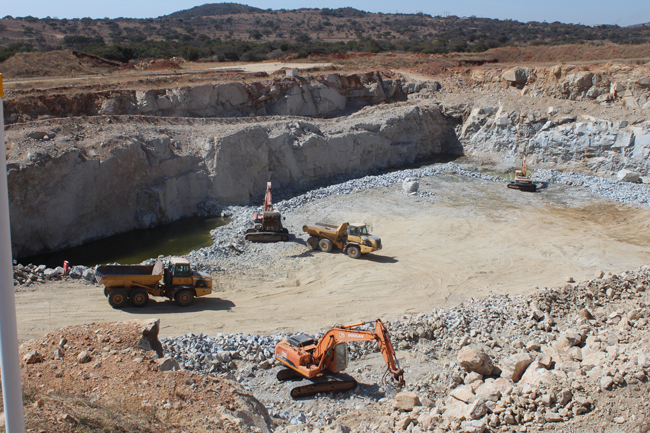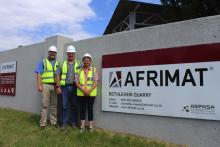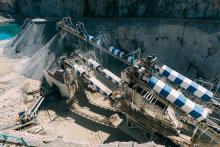
In two years of operation, Roodepoort Crusher, based in South Africa’s Limpopo Province, has grown its production capacity tenfold. Central to its early market share gains is the uncompromising emphasis on the quality of its product, writes Munesu Shoko.
Newly established Roodepoort Crusher operates a granite quarry located on the outskirts of Polokwane, the largest town in South Africa’s Limpopo Province. Its first blast went off in November 2015, and crushing started in January 2016. Part of the Alpha Sand Group, Roodepoort Crusher specialises in aggregates production, while its sister company, Alpha Sand, concentrates on sales and distribution.
For over 30 years, Alpha Sand has specialised in the buying and selling of aggregates from several quarry operators in the Polokwane area. In 2015 management took a decision to operate its own quarry. The operation is already a force to be reckoned with in the Polokwane aggregates market, despite fierce competition in the area, with two other well-established quarries located in a radius of about 5km jostling for a share of the market.
An uncompromising focus on product quality has been a key driver of Roodepoort’s early success. A massive jump in sales from 2,000tonnes/month in 2015 to 20,000tonnes/month is testimony to the early market share gains.
“Over the years, we have gained a lot of experience in the aggregates industry through our sales and distribution business, Alpha Sand. Having previously purchased aggregates from different quarries, we identified the opportunity to extend our business by establishing our own operation. This has also allowed us to have better control of all the processes, from drilling and blasting, to crushing and screening, to ensure better product quality,” explains Niekie van Waveren, director at Alpha Sand Group.
Jan van Waveren, another director at Alpha Sand Group, reiterates that quality is non-negotiable at Roodepoort Crusher, adding that there is a stronger emphasis on it than quantity. Key quality enablers are washing and product shaping. Phillip Botha, mine manager at Roodepoort Crusher, says material washing is helping improve the quality of end products, thus adding enormous value to the operation.
“Our washing strategy is already yielding tangible results. Producing high-quality washed sand enables us to obtain a premium in the market. We have a clever system of washing our product, and it’s unique to us. We have had some people coming from as far as Finland to see our innovative washing system,” says Botha.
The quality of Roodepoort Crusher’s aggregates is also based on the shape of its end product. There is a growing demand for cubical-shaped material in asphalt and concrete production at the expense of flaky material. Flaky material is weak and can be broken by the pressure of large vehicles, while an exposed hole will fill with water and quickly become a pothole. The water demand is also higher for flaky material compared with cubical material, and this increases the amount of cement needed to achieve the required strength of concrete. Cubical-shaped material also greatly increases the workability of the various mixes.
Cubical-shaped stone fits close together and more compactly, ensuring that less asphalt (or cement) is required in production, thereby reducing costs significantly. “We have experienced increased demand for our product as a result of these innovations,” explains Botha.
To ensure optimal quality of the end product, maximum controls are implemented throughout the production process. It starts in the pit, where drilling and blasting, outsourced to contractor Demwreck, is undertaken every second month. Blasts are kept fairly large at 20,000m³ of material on the ground. With proper fragmentation in mind, which has a significant impact on downstream processes such as crushing and screening, as well as load and haul, management specifies the use of high-quality electronic detonators from leading South African supplier, BME.
Electronic detonation has become popular due to its reliability, accuracy and flexibility, making blasting more predictable and allowing for larger and more cost-effective blasts. BME – which has built a strong reputation in the mining and quarrying sectors in Africa and Australia – has been behind some of the world’s largest surface blasts in terms of the number of electronic detonators fired in a single blast. For example, at Zambia’s Kansanshi Mine – the largest copper mine in Africa – 6,690 electronic delay detonators were successfully initiated in one blast in 2017 using the AXXIS system.
With load and haul being one of the biggest cost drivers for any operation, distances from the pit to the processing plant have been kept at a maximum of 700m. Two
Two 20tonne
One of the key challenges in the pit is the oversize material from blasts. The pit is still in its infancy, so when they blast there are significant residual boulders. This is largely due to the loose joints in the granite rock; the looser the joints, the poorer the fractioning when blasting.
To kick-start the business, management at Roodepoort opted for a cheaper Chinese processing plant which was designed specifically to meet the operation’s needs. The team travelled all the way to China to incorporate their “voice” in the design of the plant. However, this was a temporary solution just to get the business off the ground. A year later, parts of the plant were replaced with tried and tested brands.
“The Chinese plant was an impermanent solution. It was never going to be sustainable – our granite material is too abrasive and hard to handle, with very high silica content,” explains Botha. The crushing plant has since been replaced with a
Haulers tip directly into the primary jaw crusher. From there, material goes onto an intermediary stockpile (ISP), which at any given point holds three days’ worth of production material. An additional two days’ worth of material is stockpiled close to the plant. This allows up to five days of production without hauling from the pit, in case there are any mining stoppages in the pit.
From the ISP material goes to a triple-deck screen. Here the oversize stone is sent to the secondary crusher, a Metso GP220 cone crusher connected with a close loop conveyor set-up with the triple-deck screen. All the -8mm sand is removed out of the circuit and sold as scalping sand, mainly used for brick making. The +8mm to -32mm stone is sent to the tertiary stage of crushing, provided by a Techroq T12R VSI crusher, to be shaped.
Shaping the stone generates a lot of crusher sand, but unlike the scalping sand, this sand is well shaped and intended for the high-end market. Downstream from the tertiary crusher the aggregate passes over a series of screens, separating the different fractions and stockpiling them.
The concrete stone sizes produced are 19mm, 13.2mm, 9.5mm and 6.7mm, all being washed before dropped on stockpiles. Finally, the -5mm crusher sand is also stockpiled. Future plans include washing the -5mm sand in order to begin replacing natural sand, which is fast becoming a scarce commodity in the area.
Concrete products are the biggest market drivers for Roodepoort with some strategic customers, such as Coreslab, PPC 3Q Readymix, Technicrete and Much Asphalt, located within a kilometre of the operation. Polokwane is a big hub for concrete products, largely driven by the demand from property developers and the demand for prefabricated products over the entire Limpopo province. In spite of the tough economic spell in South Africa, the property market in Polokwane remains very active, having topped the R1.1 billion (around US$76 million) mark in 2017.
To maximise profitability, all material from the pit is processed, with no waste on site. Overburden material is separately crushed using a
A






